Page 113 of 370
Downloaded from www.Manualslib.com manuals search engine Features & Controls
..I I
Low Coolant Warning Light
If this light comes on, your system is
overheat. See the Index under Engine
Coolant and have your vehicle serviced
a low on coolant and the engine may
Driver Infomtation Center
The Driver Information Center (DIC)
gives you important safety and
maintenance
facts. It will display
warning lights
€or the following:
LOW COOLANT
LOW TIRE PRESSURE [Option]
SERVICE LTPWS (Low Tire
Pressure Warning System) [Option]
INFL REST (Inflatable Restraint)
(Charging System)
I12
SERVICE ABS (Anti-Lock Brake
SERVICE ENGINE SOON
SERVICE RIDE CONTROL
[Option]
LOW OIL
ABS ACTIVE
SERVICE ASR (Acceleration Slip
Regulation)
ASR ACTIVE
ASR OFF
PASSIVE KEYLESS ENTRY
System) as soon as you can.
Page 118 of 370
Downloaded from www.Manualslib.com manuals search engine NOTICE i I 1 ABS Active Light
This light c0me.s on when the-anti-lo-clr
brake system is engaged to prevent
wheel lock when
braking. You may hear
or. feel the-anti-lock system running
through a diagnostic test. This light will
also
come on as a test for .about two
seconds
when the engine is ‘started.
Service ABS Light
This light will come on as a test for
.about- two seconds when the engine is
.started.
If it stays on, - or comes an while you are
driving, carefully stop your vehicle as
.soon as you can and turn the ignition
off. Then start the engine to restart the
system.
If the SERVICE ABS light
stays
on, or it comes on again while you
are driving; the anti-lock system needs
service. Unless the BRAKE warning
light is also on,. you will still have
brakes, but not ABS.
See the Index under-How the Anti-Lock
SyStePn Works. ..
Page 121 of 370
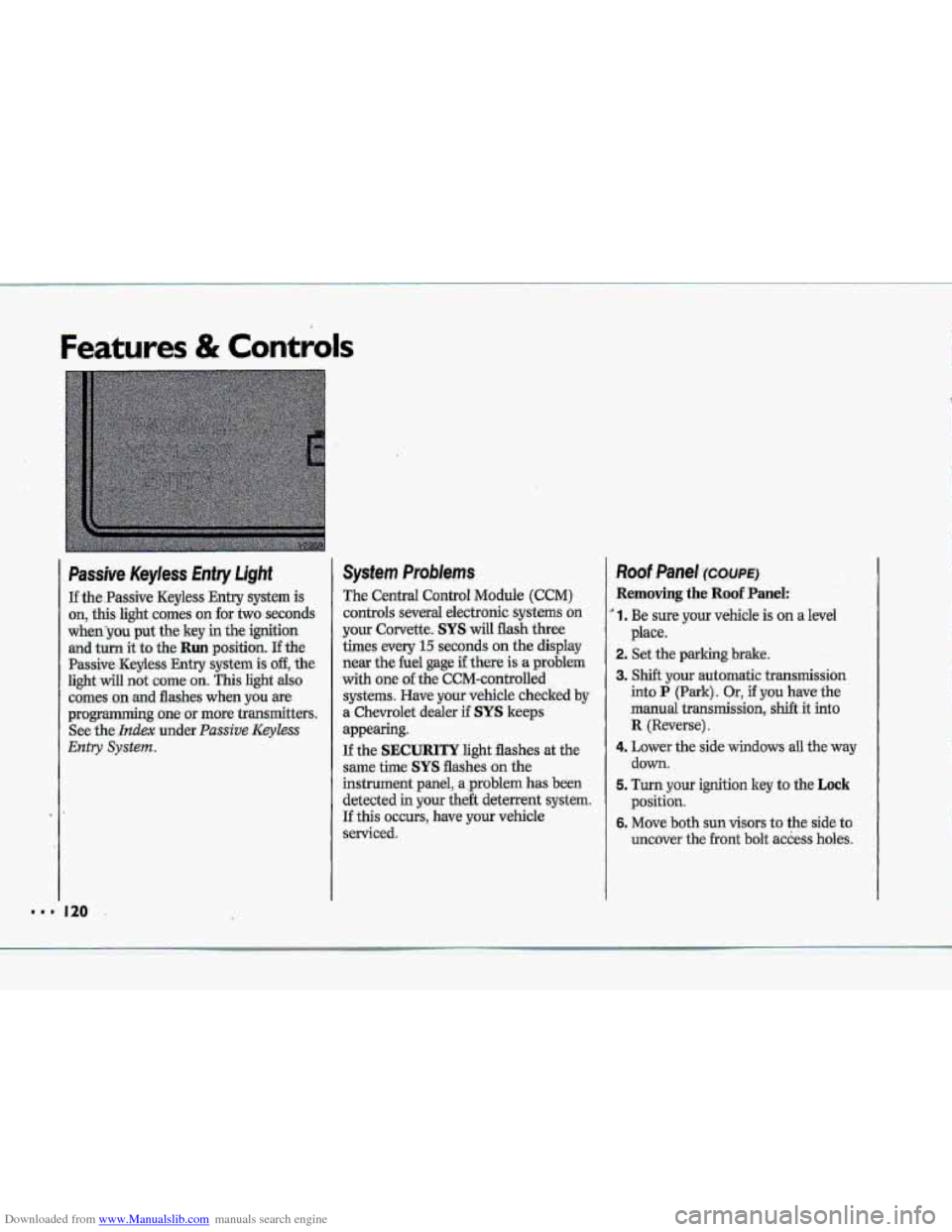
Downloaded from www.Manualslib.com manuals search engine Features & Controls
Passive Keyless Entry Light
If the.Passive Keyless Entry system is
on, this light comes on for two seconds
whenyou put the key in the ignition
and turn it to the Run position. If the
Passive -Keyless Entry .system is off, the
light will not cume on. This light also
comes on .md flashes when you we
programming~ one or more transmitters.
See
the- Index under. Passive Keyless
Entry System.
System Problems
The Central Control Module (CCM)
controls several electronic systems on
your Corvette. SYS will flash three
times every
15 seconds on the display
near the he1 gage if there is a problem
with one of the CCM-cantrolled
systems. Have your vehicle checked
by
a. Chevrolet dealer if SYS keeps
appearing.
If the SECURITY light flashes at the
same the SYS flashes on the
instrument panel, a ,problem has been
detected in your the& deterrent system.
If this OCCUTS, have YQW vehicle
serviced.
Roof Panel ~XWE)
Removing the Roof Panel:
' 1. Be sure your vehicle is on a level
2. Set the parking brake.
3. Shift your automatic transmission
into P (Park). Or, if you have the
manual
transmission, shift it into
R {Reverse).
4. Lower the side windows all the'way
down.
5. Turn your ignition key to the Lock
position.
6. Move both sun visors to the side to
uncover the
.front bolt access holes.
place.
k p*
.&
"' 120
Page 126 of 370
Downloaded from www.Manualslib.com manuals search engine rh To Lower Your Convertible Tow
~~~ ~
. Park on a level surface, set the
parking brake
firmly, shift an
automatic transmission into
P (Park)
and shut off the engine. Shift a
manual transmission into R (Reverse).
Then lower both
windpp and-sun
visors.
E
i 1. Unlock the front of the convertible
top by turning the latch handles
outward and then
lift the top off the
windshield slightly. Then unfasten
the
Velcro@ strips at the rear of each
window opening.
I
3. Tilt the driver's seatback forward.
The convertible top release handle is
located behind the driver's seat and
beneath the deck
lid. Pull the release
handle
forward to unlock the rear of
the convertible top, then lift and hold
the rear
of the convertible top.
Page 168 of 370
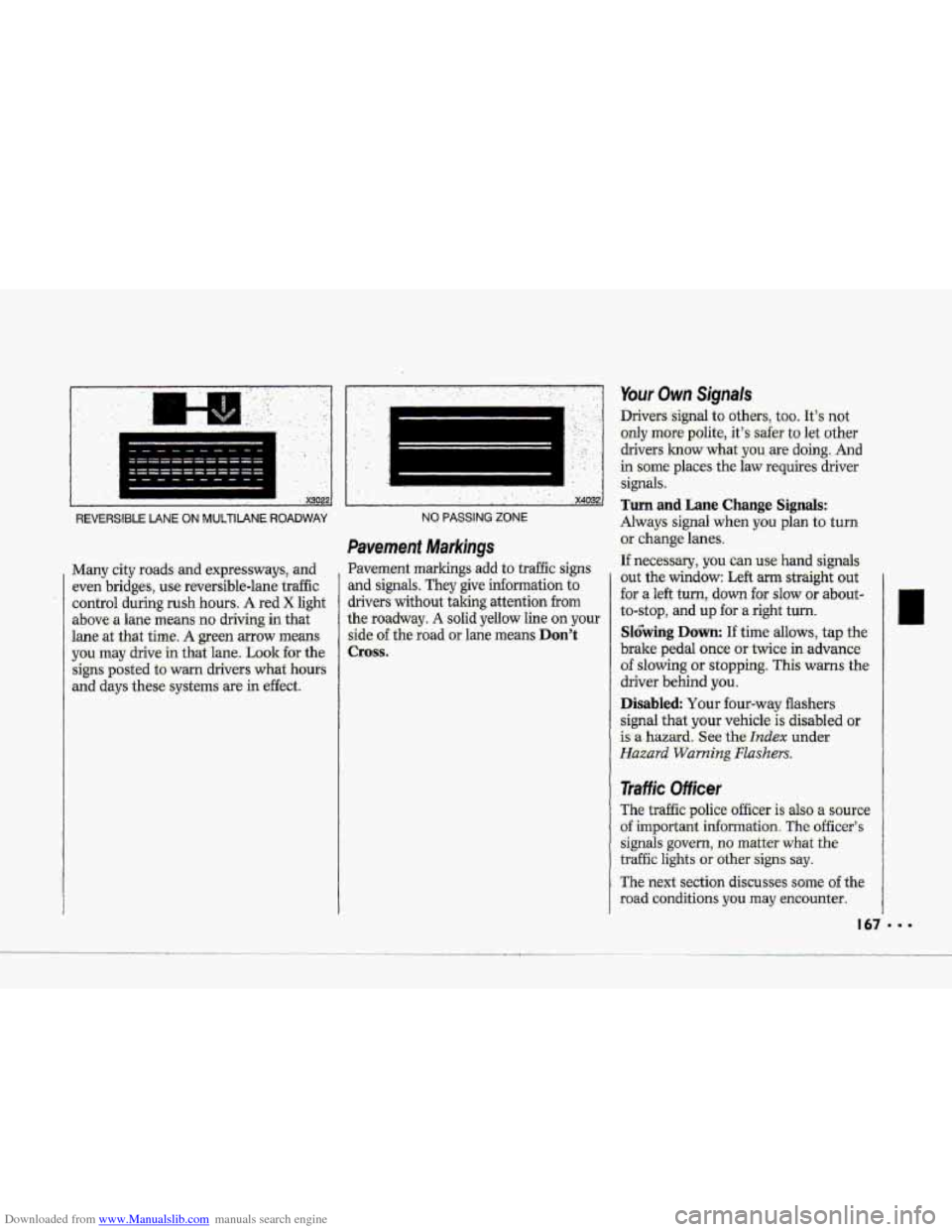
Downloaded from www.Manualslib.com manuals search engine c
R
II
I
1 .---
I I
1
,, -' , . x3022
REVERSIBLE LANE ON MUlTIIANE ROADWAY
Many city roads: and expressways, and
even bridges, use reuersible-lane traffic
control during
rush hours. A red X light
above- a lane means no driving in that
lane
at .that time. A green mow means
you may drive in that lane. Look €or the
signs posted to warn drivers
what hours
and days these = ,-.. systems are in effect.
.. ........... ........................ ... ,. ., ,. . ... . ' .' '. , ..
! ' x4032
NO PASSING ZONE
Pavement Markings
Pavement markings add to traffic signs
and signals. They give information to
drivers without iaking attention
from
the roadway. A solid yellow line on your
side of the road or lane means Don't
Cross.
Your Own Signals
Drivers -signal to other.s, too. It's not
only more polite.,. it's safer to let other
drivers
1mow what-you are doing-. And
in some' places the law requires driver
signals:
Turn and Lane Change Signals:
Always signal when you plan to turn
or .change lanes.
If neces-ssary, you can use hand signals
out the window: Left arm straight out
'for a left turn, down for slow :or about-
to-stop, and up for .a right turn.
Sl6bing Down: If time allows, tap the
brake pedal once or twice in advance.
of slowing or stopping. This warns the
driver behind
you.
Disabled Your four-wtiy flashers
signal
that. your vehicle is disabled or
is a hazard. See the hdex under
Hazard Warning Flashers.
Traffic Officer
The traffic police officer is also a source
of important information The officer's
signals govern, no matter what the
traffic lights or othersigns say.
The next section discusses some of the
road conditions you may encounter.
Page 173 of 370
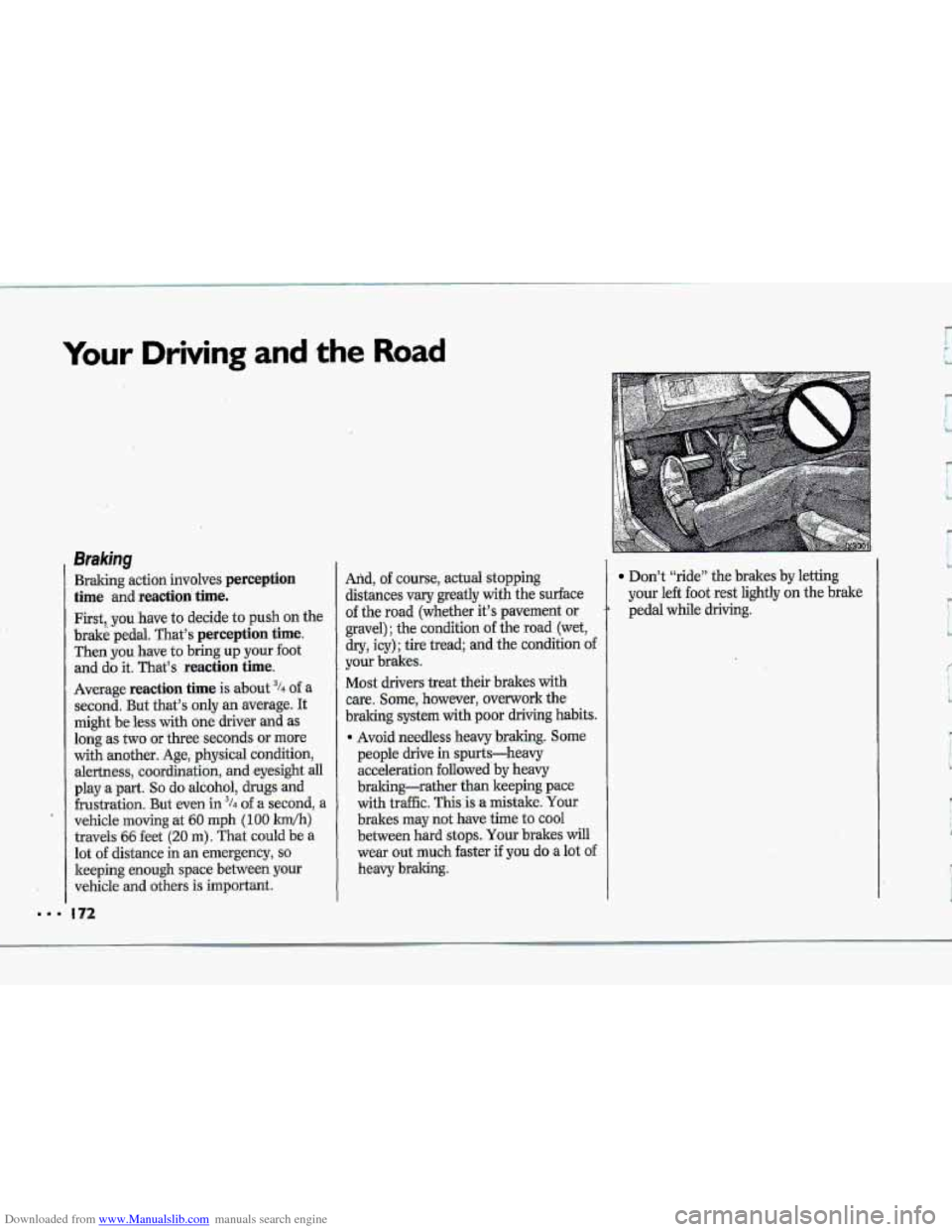
Downloaded from www.Manualslib.com manuals search engine Your Driving and the Road
Braking
Braking action involves perception
time .and reaction: time.
First, you have.to .decide to push on the
br&i pedal. That’s perception time.
Then you have to bring up your foot
and do it. That’s reaction time.
Average reaction time .is about 3/4 -of, a
second. But that’s only an average. It
might be less with one driver and- as
long as two or three seconds or mQre
with another. Age, physical condition,
alertness, coordination, and eyesight all
play a part. So do alcohol, drugs and
frustration. But even in 3/4 of a second, a
vehicle moving at
60 mph (100 Wh)
travels 66 feet (21) m). That could be a
lot
of distance in an emergency, so
keeping enough space between your
vehicle and others
is important.
And, of course, actual stopping
distances vary greatly with the surface
of the road (whether it’s pavement or
gravel) ; the conditian uf the road (wet,
dry, icy); tire tread; arid the. condition of
your brakes.
Most drivers;treat.their brakes with
care. Some, however, overwarlc the
braking system with poor driving habits.
. Avoid needless heavy braking. Some
people. drive in spurts-heavy
acceleration followed.
by heavy
braking-rather- than lreeping pace
with traffic, This.is a mistake. Your
brakes may
not have he to cool
between hard.stops. Your brakes will
wear out much faster if you do a lot of
heavy braking.
Don’t “ride” the brakes by letting
your left
foot rest lightly on the hake
pedal while driving.
I“
L
Page 174 of 370
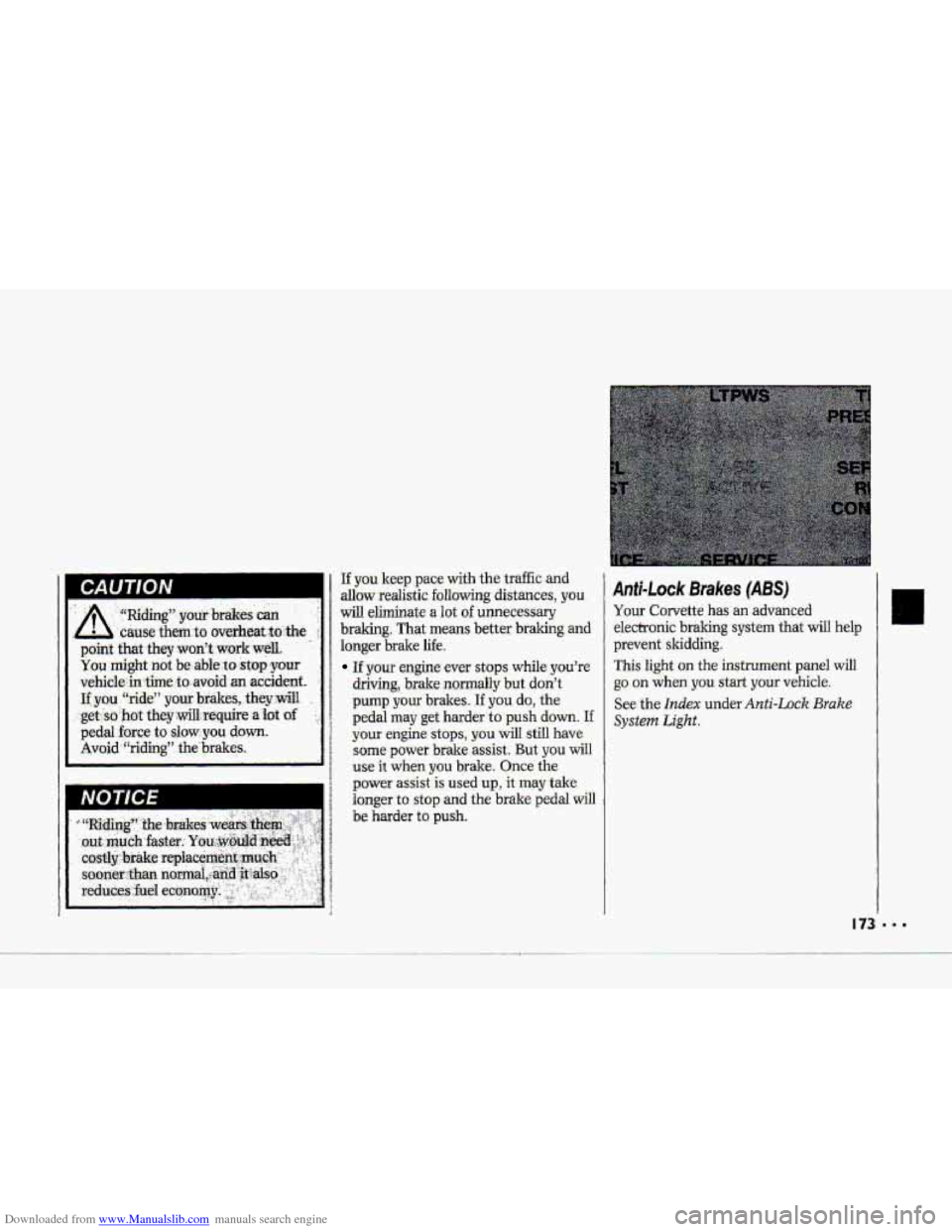
Downloaded from www.Manualslib.com manuals search engine A,,
“Riding” yom brakes. can
cause them to overheat $u:,~&e
point that they.won’t work well.
You might not be able to-stop .your
vehicle in time -to avoid an accident.
If you “ride” your bides,. they w3’i
get, suhot they :direquire a bt of
pedal force to slow you down.
Avoid “riding” the’brakes.
INoTIcE .
If you keep pace with the traffic and
allow realistic following distances, you
will eliminate a lot of unnecessary
braking. That means better braking and
longer brake
life.
If your engine ever stops while you’re
driving, brake normally but don’t
pump your brakes. If you do, the
pedal may get harder to push down. If
your engine stops, you wilI still have
some power brake assist. But you will
use it when you brake. Once the
power assist is used up, it may take
Homgez ta stop and the brake pedal will
be harder to push.
Anti-L~ck Brakes (ABS)
Your Corvette has an advanced
electronic braking system that will help
prevent skidding.
This light on the instrument panel will
go on when you start your vehicle.
See the Index under Anti-Lock Brake
System Light.
Page 176 of 370
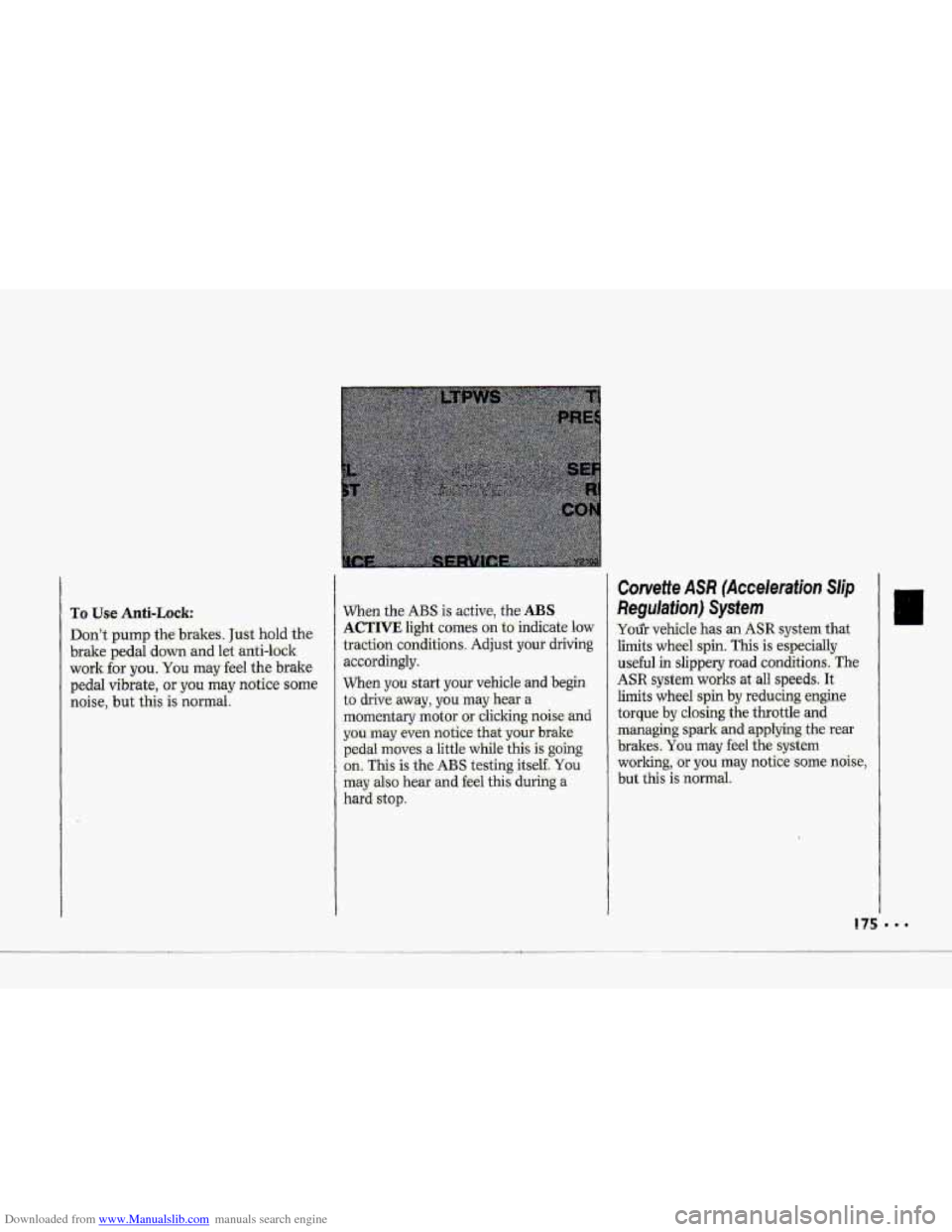
Downloaded from www.Manualslib.com manuals search engine P TO Use Anti-L.ock:
Don't pump the brakes. Just hold the
brake pedal downand let anti-lock
work for you. You may feel the brake
pedal
vibrate, or you -may notice some
noise,
but thi.s is normal.
When the ABS is active, the ABS
ACTIVE light- conies on to-indicate luw
traction conditions.
Adjust your -driving
accordingly.
When
you start your vehicle and begin
to drive away, you may hear a
momentary motsr Qr .clicking, noise-and
you. my even notice that, yow bmke
pedd -moves a little while this is going
on.
This is the ABS test-ing itself. You-
may also hear and feel this durihg a
hard stop.
Corvette ASR (Acceleration SIip
R.egulati0.n) System
Yo& vehicle has an ASR system that
limits wheel
spin. This is especially
useful in slippery road conditions. The
ASR system works at all speeds. It
limits
wheel spin by reducing englne
torque
by cLusing the throttle and
managing
sp'ark and .applyiag the rear
brakes. You may €&el the system
working., .or
you may notice some noise,
but this is normal.